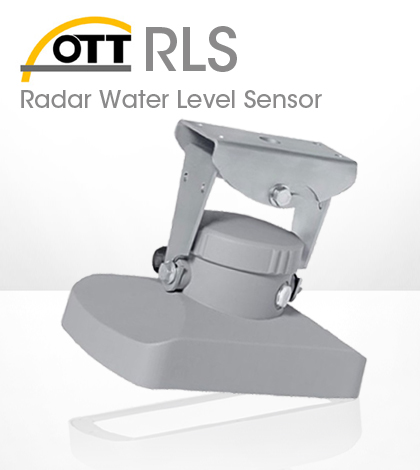OTT RLS Radar Water Level Sensor offers solid design and proven reliability

There are lots of options for hydrologists looking to measure water levels. These include pressure transducers, sonar sensors and common staff gauges.
But of all the equipment out there, many turn to the OTT RLS Radar Water Level Sensor for tracking water levels in streams and rivers. The sensor is a go-to for sites prone to flooding, debris or high sediment concentrations that make measurements difficult.
“It’s ideal for those sites, and for tide level monitoring and for sites requiring rapid deployment solutions,” said Christel Valentine, product manager for OTT Sensors.
The OTT RLS is a popular instrument with universities and government agencies. One reason is that the RLS reaches the U.S. Geological Survey’s water level accuracy requirements of +/- 0.01 feet. The robust design features that OTT Hydromet packed into the sensor’s small size also make it a solid choice.
“The overall design itself, with its flat antenna, makes it compact, very easy to work with and install,” said Valentine. “It’s virtually maintenance-free and really unique in the industry that it deploys very quickly.”
The easy installation, often in hard-to-reach locations under bridges or structures, is due to the RLS’ small size and composite construction that keeps it lightweight. The grey color allows it to blend in with its surroundings beneath bridges and other constructions. From an aesthetic standpoint this helps a lot, but it also helps to protect the OTT RLS from vandalism. The composite is also resistant to corrosion and the effects of ultraviolet light.

An OTT RLS Radar Water Level Sensor mounted in a bridge application. (Credit: OTT Sensors)
On the inside, the OTT RLS incorporates flat antennas to send and receive signals from the water below. This design feature allows the sensor to support a flat white Teflon plate over its sensing unit to ensure nothing sticks that could obstruct readings. It’s a big advantage over other sensors on the market that still use open horn antennas.
“That’s an important design feature because it keeps anything from sticking to it, like spider webs or mud dobbers,” said Valentine.
Adding to its reliability are the OTT RLS’ temperature-compensated measurements. They are key to ensuring accurate water level data throughout the life of any project. And since the compensation is integrated into the sensor, there’s no need for offsets or adjustments in the field.
On top of the temperature compensation, the sensor’s performance is likewise unaffected by debris or pollution in the water, humidity or choppy wake that can topple other water level sensors.
“Radars are unaffected by debris because they’re completely above the water,” said Valentine. “The OTT RLS takes about 320 measurements over a period of 20 seconds and calculates an average.”
The sensor connects with industry-leading data loggers from NexSens Technology and communicates via RS485 and SDI-12. Using the RS485 interface running the SDI-12 protocol, Valentine says the sensor can be deployed up to 3,000 feet away from a logger.
Troubleshooting is a breeze through SDI-12, as users can simply type in a few commands through terminal software and receive a data string containing key device info like measurement status, signal-to-noise ratio and amplitude signal. Maintenance concerns are minimal, as they are mostly confined to the installation process.
“You can do a cross-validation with a staff gauge. Make sure the orientation (of the OTT RLS) is parallel to the water’s surface,” said Valentine. “Other than that, users just need to maintain the power supply.”





0 comments